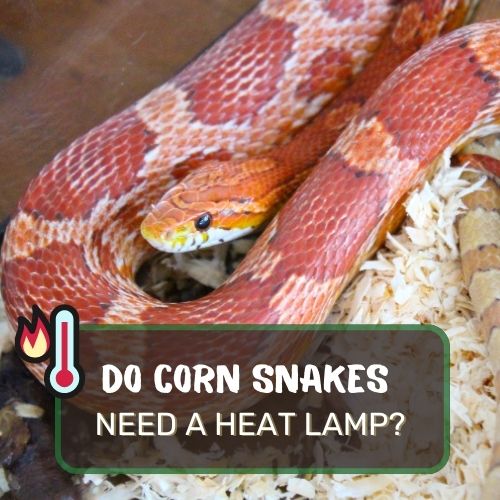
It’s a question that has crossed the mind of every budding reptile enthusiast.
As you dive into the world of corn snake care, understanding their heating requirements becomes paramount.
In this comprehensive guide, we’ll unravel the mysteries of temperature regulation for these fascinating creatures.
From the science behind their ectothermic nature to the practicalities of setting up the perfect habitat, we’ve got you covered.
We’ve delved deep, considering factors like natural behaviors, alternative heating methods, and the role of UV lighting.
By the end of this read, you’ll not only have an answer to the burning question but also a roadmap to ensure your slithery friend thrives in its cozy haven. Dive in and discover the warmth of knowledge!
Table of Contents
Do corn snakes need a heat lamp? (Summary)
Yes, corn snakes do need a heat lamp. Being ectothermic creatures, corn snakes rely on external sources to regulate their body temperature. In the wild, they achieve this by basking in the sun or seeking warmth from heated surfaces. In captivity, a heat lamp replicates this natural heat source, providing the snake with a warm area to bask and maintain its body temperature. It’s essential to set up a temperature gradient in their enclosure, allowing the snake to move between warmer and cooler areas as needed. Proper temperature regulation is crucial for their digestion, metabolism, and overall well-being.
The Basic Need for Heat
Explanation of Reptiles Being Ectothermic
Ever wondered why you see reptiles like lizards lounging on rocks under the sun? It’s not just because they’re enjoying a lazy afternoon. Reptiles, including our friend the corn snake, are ectothermic.

This is a fancy way of saying they can’t generate their own body heat like we humans can. Instead, they rely on external sources, like the sun, to regulate their body temperature.
Imagine having to sunbathe every time you felt a chill!
The Natural Behavior of Corn Snakes in the Wild
Now, let’s picture a corn snake in its natural habitat. It’s a sunny day in the southeastern United States, and our corn snake is feeling a bit chilly.
What does it do?
It slithers its way to a sunlit patch or perhaps finds a warm rock that’s been baking under the sun. This is the snake’s way of “turning up the heat.” It’s a natural behavior that’s been ingrained in them for millennia.
But here’s a fun fact: at times, when it gets too hot, the same snake might seek shade or burrow into the ground to cool down. It’s all about finding that perfect temperature balance.
The Necessity of Providing an Alternative Heat Source in Captivity
Now, let’s bring our corn snake into a domestic setting. Without the vast landscapes and varying temperatures of the wild, how can it regulate its body temperature?
This is where our main question comes into play: “Do corn snakes need a heat lamp?”
The answer is a resounding yes. In captivity, corn snakes don’t have the luxury of finding that sunlit patch or warm rock. We need to replicate that environment for them.
A heat lamp serves as a substitute for the sun. It provides the warmth they need to maintain their body temperature.
But it’s not just about turning on a lamp and calling it a day. Remember the temperature balance we talked about?
In captivity, it’s crucial to provide a temperature gradient, meaning one side of their enclosure is warmer (thanks to the heat lamp), while the other side is cooler.
This allows the snake to “move” between temperatures, just like it would in the wild.
In essence, while the sun and warm rocks are the go-to heat sources for corn snakes in the wild, in captivity, it’s our responsibility to provide that warmth.
And a heat lamp is the perfect tool for the job. So, the next time you see a corn snake basking under its lamp, you’ll know it’s just doing what comes naturally, albeit with a little help from its human caretakers.
The Role of Heat Lamps
The Concept of a Temperature Gradient within the Snake’s Cage
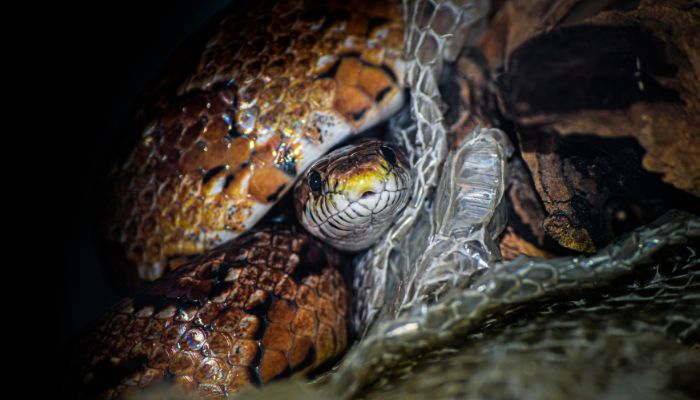
Let’s dive a bit deeper into this idea of a temperature gradient. Imagine you’re at a beach. On one side, you have the sun beating down, and on the other, the cool shade of a tree.
Now, if you’re feeling too hot, you’d naturally move to the shade, and if you’re feeling chilly, you’d bask in the sun.
This is precisely the kind of environment we aim to create for our corn snake within its cage—a range of temperatures to choose from, depending on its needs.
In the wild, corn snakes have the freedom to move between different temperatures. In captivity, we need to simulate this freedom.
By providing a temperature gradient, we’re essentially giving our snake a choice: “Hey, feel free to warm up or cool down as you please!” It’s like offering a buffet of temperatures, and trust me, our slithery friend appreciates it.
How Heat Lamps Help in Achieving this Gradient
Heat lamps are the magic tools that make this gradient possible. By placing a heat lamp on one side of the cage, we create a “hot zone.” This is where our corn snake can bask and soak up all the warmth it needs.
The other side of the cage, away from the lamp, remains cooler, offering a place to retreat when things get a tad too toasty.
But here’s the kicker: it’s not just about providing warmth. It’s about providing the right kind of warmth. And this is where the magic of heat lamps truly shines.
Different Types of Heat Lamps Available for Reptiles
Imagine a lineup of different bulbs, each with its unique glow. Some emit a soft, red light, while others shine bright white. These are the various heat lamps available for reptiles.
- Infrared Heat Lamps: These emit a gentle red glow and are perfect for nighttime as they don’t disturb the snake’s sleep cycle.
- Ceramic Heat Emitters: These don’t give off any light, only heat. They’re great for maintaining temperatures, especially during the night.
- Basking Bulbs: Bright and warm, these bulbs replicate the sun’s rays, providing both light and heat for our corn snake to bask in.
Each of these lamps has its unique role and can be used depending on the specific needs of the snake and the setup of the enclosure.
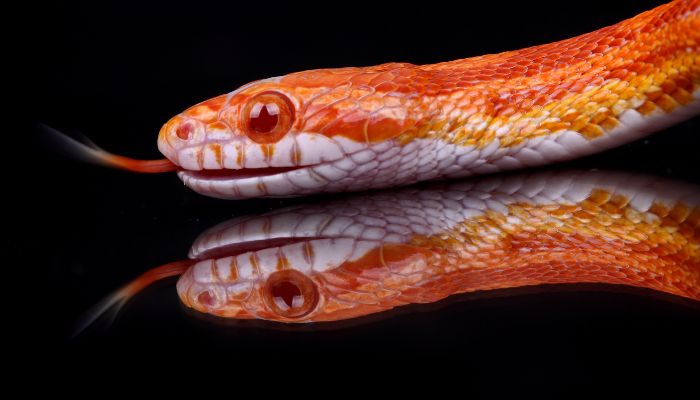
Adjusting the Power of the Lamp to Achieve the Right Temperature
Now, just having a heat lamp isn’t enough. It’s like having a car but not knowing how to drive it. The power of the lamp needs to be adjusted to ensure the temperature is just right. Too hot, and you risk harming the snake.
Too cold, and well, it defeats the purpose.
Most heat lamps come with adjustable settings, allowing you to regulate the heat output. Using a reliable thermometer, you can monitor the cage’s temperature and adjust the lamp’s power accordingly.
Remember, our goal is to create that perfect temperature gradient, and this might require some tweaking and adjusting initially.
It’s also worth noting that the ambient room temperature plays a role. If it’s winter and the room is chilly, you might need to crank up the heat lamp a bit more. Conversely, in the heat of summer, a gentler setting might suffice.
Heat lamps are more than just light sources. They’re essential tools that replicate the natural environment of corn snakes, ensuring they remain healthy and happy in captivity.
With the right setup and adjustments, you can create a cozy haven for your reptilian friend, making sure it feels right at home.
Ideal Temperatures for Corn Snakes
The Temperature Range in Which Corn Snakes Thrive
Corn snakes are not too picky, but they do have their comfort zone. The ideal temperature range for these slithery beings lies between 70°F to 88°F (21°C to 31°C). Picture this range as the snake’s “comfort blanket.”
Within this spectrum, the corn snake feels at home, safe, and energetic.
On the cooler side, temperatures shouldn’t dip below 70°F. This is the snake’s chill-out zone, where it can escape if it feels too warm. On the flip side, the warmer basking area shouldn’t exceed 88°F.
This is where the snake goes to soak up the heat, much like we might enjoy lounging in a sunlit spot on a chilly day.
Importance of Monitoring the Snake’s Behavior to Adjust Temperatures
While thermometers and gadgets give us a numerical perspective, observing your snake’s behavior offers invaluable insights. Is your snake always hiding in the cooler end?
Or is it perpetually basking, even at night?
These behaviors can be telltale signs that the temperature needs tweaking.
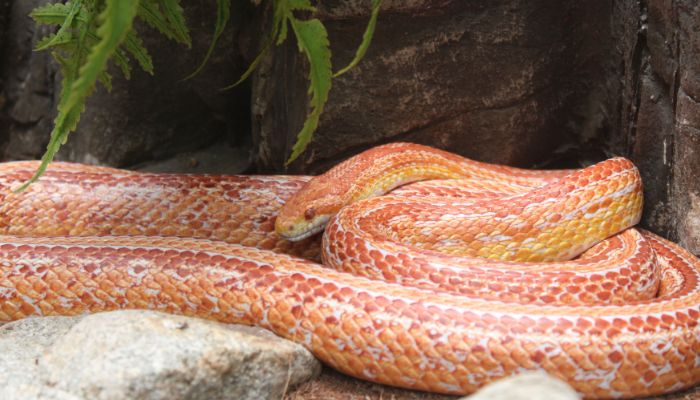
Observations to Make Regarding the Snake’s Position in the Cage
The position of your corn snake in its cage is like a live thermometer. If your snake is constantly on the cooler side, it might be hinting that the warm side is a tad too hot.
Conversely, if it’s always basking and rarely ventures to the cool side, it might be feeling too cold overall.
Remember, in the wild, these creatures have the freedom to move between various temperatures. In captivity, we need to ensure they have the same choices.
Their position in the cage is their way of communicating their comfort level to us.
UV vs. Heat Lamps
Differences Between Heating and UV Light Bulbs
When we talk about reptile lighting, it’s essential to distinguish between heat lamps and UV bulbs. Heat lamps, as we’ve discussed, primarily provide warmth. They replicate the sun’s heat but not necessarily its light.
On the other hand, UV bulbs are designed to mimic the sun’s ultraviolet rays, which are invisible to the naked eye but crucial for many reptiles.
The Importance of UVB Lighting for Reptiles, Including Snakes
Now, you might wonder, “Do snakes really need UVB?” While snakes can survive without UVB lighting, they certainly benefit from it.
Most reptiles, especially lizards, require UVB for vitamin D synthesis, which in turn helps in calcium absorption. While snakes get most of their vitamin D from their diet, UVB lighting can still offer additional benefits.
Benefits of Using UVB Lighting in Captivity
Firstly, UVB lighting can enhance the natural colors of your corn snake, making their scales pop and shimmer.
It’s like giving them a natural glow-up! Secondly, UVB helps in establishing a day-night cycle, essential for the snake’s overall well-being and circadian rhythm.

Moreover, there’s growing evidence suggesting that snakes in captivity benefit from UVB exposure. It makes sense, considering they do get a dose of these rays in the wild.
So, while heat lamps ensure your corn snake stays warm and toasty, UVB lighting ensures they stay radiant and healthy. It’s a win-win!
Alternative Heating Methods
Introduction to Other Methods Like Heat Mats and Flexwatt Tape
While heat lamps are the go-to for many reptile enthusiasts, they’re not the only game in town. Enter heat mats and flexwatt tape.
Think of these as the underfloor heating systems of the reptile world. Instead of radiating heat from above, these devices warm up the base of the enclosure, providing a gentle, consistent warmth that snakes can lounge on.
Pros and Cons of Using Under-Tank Heating Methods
Pros:
- Consistency: Under-tank heaters provide a steady source of heat, ensuring the base remains warm even during colder nights.
- Safety: With no bulbs to potentially shatter or burn out, they can be a safer alternative.
- Stealth: Being under the tank, they’re discreet and don’t interfere with the aesthetics of your setup.
Cons:
- Heat Distribution: They heat from the bottom, which might not provide the same gradient a lamp can offer from above.
- Potential Overheating: If not monitored, they can get too hot, potentially harming the snake or damaging the enclosure.
Recommendations on Controlling the Output of These Devices
Just like with heat lamps, control is key. Many heat mats and tapes come with adjustable thermostats. If not, it’s wise to invest in one.
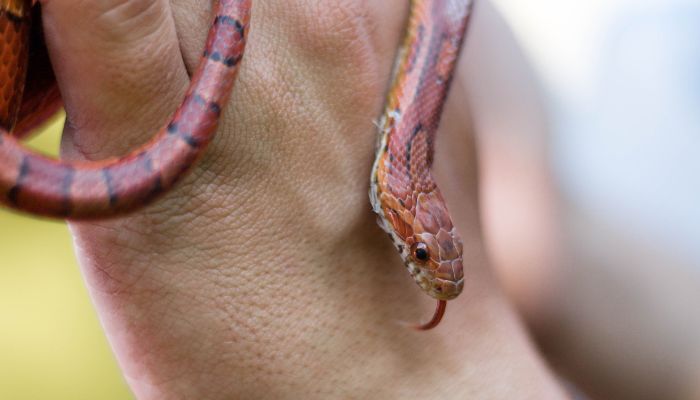
This allows you to set the desired temperature, ensuring the mat doesn’t overheat. Regularly checking and adjusting based on the ambient room temperature is crucial.
Importance of Measuring the Temperature Inside the Cage
Regardless of the heating method, monitoring the inside temperature is paramount. It’s the only way to ensure your snake’s environment is optimal.
After all, even a few degrees off can make a significant difference to your pet’s comfort and health.
Practical Tips for Setting Up a Heat Source
Steps to Set Up a Heat Lamp for a Corn Snake’s Habitat
- Positioning: Place the heat lamp on one side of the cage to create a temperature gradient.
- Safety First: Ensure the lamp is securely fixed and there’s no risk of it falling into the enclosure.
- Distance Matters: The lamp shouldn’t be too close to the snake. Ensure there’s a safe distance to prevent burns.
Tools to Measure Temperature: Adhesive Stick-On Thermometer Strip and Temperature Gun
While the adhesive stick-on thermometer strip gives a quick read of the temperature, a temperature gun provides a more accurate and instantaneous reading.
By pointing and shooting, you can gauge the exact temperature of a specific spot in the enclosure.
Adjusting the Heat Source Based on the Snake’s Behavior
Your corn snake is an excellent communicator if you know what to look for. Constantly hiding away? Maybe it’s too hot. Always under the lamp? Perhaps it’s too cold. Adjust the heat source based on these behaviors.
Remember, it’s all about creating a comfortable and natural environment for your slithery companion.
Conclusion
In the world of reptile care, understanding and catering to the specific needs of your pet is paramount. For corn snakes, temperature regulation stands out as a cornerstone of their well-being.
These ectothermic creatures rely heavily on their environment to maintain their body temperature, making it our responsibility as caretakers to provide them with the right conditions.
As we’ve delved into the intricacies of heat lamps, mats, and the importance of temperature gradients, one thing becomes crystal clear: the well-being of our slithery friends hinges on our attention to detail.
It’s not just about providing warmth; it’s about providing the right kind of warmth.
To all the snake keepers out there, remember that your pet relies on you. Regularly monitor their behavior, adjust conditions as needed, and ensure they have a comfortable environment that mirrors their natural habitat.
In doing so, you’re not just ensuring their comfort but also their health and longevity.
FAQ
Do corn snakes need a heat lamp or mat?
Both options are viable. Heat lamps replicate the sun’s warmth from above, while heat mats provide warmth from below. The choice depends on your setup and preference. Some keepers even use both for optimal temperature regulation.
Do snakes need a heat lamp all the time?
Not necessarily. While they need a consistent heat source, it’s essential to provide a day-night cycle. At night, the temperature can drop slightly, mimicking natural conditions. Infrared heat lamps or ceramic heat emitters can be used during nighttime.
What can I use instead of a heat lamp for my snake?
Apart from heat lamps, options include heat mats, flexwatt tape, and ceramic heat emitters. Each has its advantages and can be used based on the specific needs of your setup.
What is the best heat source for a corn snake?
The “best” heat source depends on your setup and the snake’s behavior. Some corn snakes might prefer basking under a lamp, while others might enjoy the consistent warmth of a heat mat. Observing your snake’s behavior will give you insights into its preference.
How do you know if a snake is too cold?
Signs include lethargy, reduced appetite, and spending excessive time in the warmer areas of the enclosure. If your snake exhibits these behaviors, it might be hinting that it’s feeling too cold and adjustments are needed.

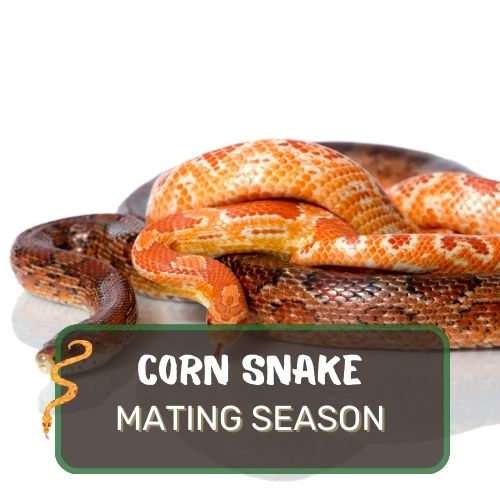


0 Comments